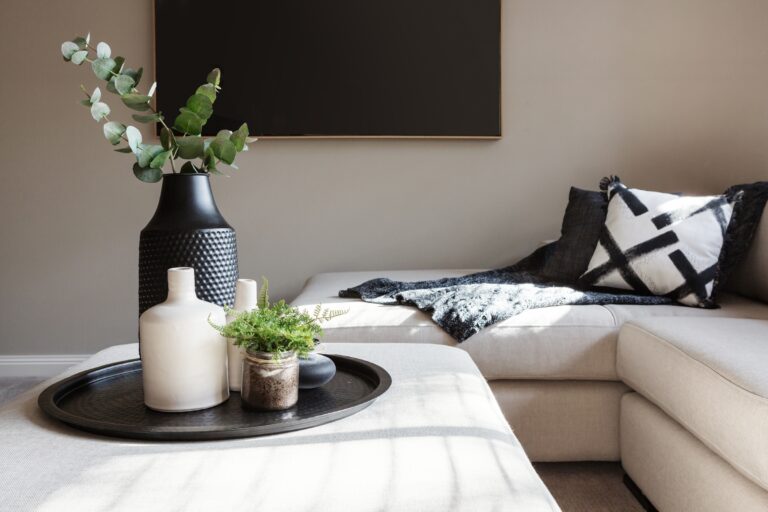Keeping up with all the creative elements of your interior design projects is exciting, but when it comes to the financial side, things can get a bit overwhelming 😅. That’s where bookkeeping comes in.
Whether you’re just getting started or looking to streamline your business, having a solid grip on your finances can make all the difference. In this post, we’ll break down exactly what bookkeepers do for interior designers and share some tips to help you stay on top of your bookkeeping game.
Table of Contents
What services do bookkeepers provide for interior designers?
Bookkeepers make your life a whole lot easier and help you focus on client work. Most bookkeepers provide these key services:
Financial record management and organization
- Recording transactions: Bookkeepers meticulously record all financial transactions, including income from clients, expenses, and purchases. This comprehensive record-keeping ensures that every financial activity is tracked.
- Categorizing expenses: They categorize expenses into specific categories such as project costs, marketing, travel, and office supplies. This helps in understanding where money is being spent and aids in budget planning.
- Maintaining digital records: Bookkeepers organize both digital receipts and documents, making it easy to access and retrieve information when needed.
Expense tracking and management
- Project-based expense management: Interior designers often have multiple ongoing projects. Bookkeepers track expenses for each project, helping designers understand the costs associated with individual projects and ensuring that they remain profitable.
- Managing reimbursable expenses: They track reimbursable expenses, such as travel, materials, or contractor fees, ensuring these are accurately billed back to the client.
- Expense reports: Bookkeepers generate regular expense reports, providing a clear overview of where money is being spent and helping designers make informed financial decisions.
Payroll management
- Processing employee salaries: If the interior designer has employees, bookkeepers might also help with managing payroll, ensuring accurate and timely payment of salaries, overtime, and bonuses.
- Contractor payments: For designers working with freelance contractors, bookkeepers track hours worked, manage payments, and ensure proper documentation for tax purposes.
- Payroll taxes and deductions: Bookkeepers calculate and withhold the necessary payroll taxes, ensuring compliance with federal, state, and local tax laws.
Tax preparation and compliance
- Tracking tax-deductible expenses: Bookkeepers track expenses that can be deducted from taxes, such as office supplies, travel expenses, and software subscriptions, ensuring designers maximize their tax savings.
- Preparing financial records for tax filing: At the end of the year, bookkeepers organize financial records, making it easier for accountants to prepare tax returns accurately and efficiently.
- Sales tax management: For designers who sell products, bookkeepers manage sales tax collection, ensuring it’s accurately charged, recorded, and remitted to the appropriate tax authorities.
Bank reconciliation
- Reconciling bank statements: Bookkeepers compare bank statements with the designer’s financial records, identifying discrepancies, errors, or unauthorized transactions. This ensures that the financial records are accurate and up-to-date.
- Resolving discrepancies: Any discrepancies between the bank statements and financial records are investigated and resolved, ensuring financial integrity.
Reporting and financial analysis
- Profit and loss statements: Bookkeepers generate monthly or quarterly profit and loss statements, providing a clear picture of the business’s profitability and financial health.
- Balance sheets: They prepare balance sheets that show the business’s assets, liabilities, and equity, offering a snapshot of financial stability.
- Cash flow statements: These statements show how money flows in and out of the business, helping designers understand their spending patterns and plan for future expenses.
Invoicing and payment tracking
- Tracking payments: Some bookkeepers might also help monitor which invoices have been paid, which are overdue, and which clients need reminders. This ensures consistent cash flow and reduces the likelihood of missed payments.
- Handling deposits and retainers: For interior designers who collect deposits or retainers before starting a project, bookkeepers track these payments and apply them correctly to project expenses.
Software integration and setup
- Implementing accounting software: Bookkeepers assist in setting up and integrating accounting software tailored to interior design businesses, such as QuickBooks, FreshBooks, or Xero.
- Training and support: They train designers and their teams on how to use accounting software, making it easier to manage finances efficiently.
Project management financial support
- Tracking project costs: Bookkeepers track costs related to specific projects, including labor, materials, and overhead, ensuring accurate project profitability analysis.
- Managing client deposits: Bookkeepers track client deposits and apply them to the appropriate project expenses, ensuring transparency and accuracy.
Collaboration with accountants and financial advisors
- Providing financial data: Bookkeepers work closely with accountants and financial advisors, providing accurate financial data for strategic planning and tax preparation.
- Preparing for audits: If the interior designer’s business undergoes an audit, bookkeepers ensure that all financial records are in order, making the process smoother and less stressful.
How much does it cost to hire a bookkeeper who specializes in interior design?
“Do not hire the first person you come across,” says Megan Dahle, a fractional CFO for interior designers. “Always get quotes. You could probably have your books done quick and dirty for $250 a month. But if you have lots of transactions, lots of detail, lots of hand-holding for your clients for specific payment terms, you can pay upwards of $1,500.”
The more your bookkeeper can automate the tracking process, the more affordable it will be for you. “For example, if they can always put vendor X in account Y and set up Quickbooks to do that for them, that’s going to cost less. But if there are a lot of tailored transactions, that’s going to be more expensive.”
Interior design bookkeepers VS accountants
“Your CPA or your enrolled agent for your taxes will use the historical information that your bookkeeper has cleaned up for compliance,” says Megan. A bookkeeper organizes and cleans up your financial data. Then, an accountant uses that information to do your taxes and help you make sure that you’re paying the right amount for your quarterly and annual tax payments.
Services that accountants provide
- Quarterly Tax Estimates: Accountants calculate estimated tax payments, ensuring designers pay the correct amount throughout the year and avoid penalties.
- Tax Compliance and Documentation: They ensure all financial records are organized and comply with tax regulations, making it easier to file taxes accurately.
- Collecting Financial Data: Accountants gather all necessary financial data, including income statements, expense reports, invoices, and receipts, to prepare accurate tax returns.
- Identifying Deductions and Credits: They identify all eligible deductions and credits specific to the interior design industry, such as home office expenses, travel costs, software subscriptions, and marketing expenses, ensuring designers maximize their tax savings.
- Completing Tax Forms: Accountants complete all required federal, state, and local tax forms, making sure they are filled out correctly to avoid errors or delays.
- E-Filing Services: They handle the electronic filing of tax returns, ensuring they are submitted promptly, which minimizes the risk of late penalties and interest charges.
How much does it cost to hire a tax accountant?
Getting business taxes done depends on where you live. You can expect to pay somewhere between $500 and $1500 to get your business taxes done. (Keep in mind that getting your personal taxes done as well will incur another fee.)
You might want to hire an accountant for your interior design business if…
If you have an S-corp (not an LLC), you might find that doing your own taxes is simply too complicated. Also, if you have enough work or enough money in the bank, you’ll find that focusing on your business is a better use of your time.
Interior design bookkeepers VS fractional CFOs
“For a lot of interior designers, bookkeeping information isn’t necessarily useful to you. Bookkeeping ends up being compliance work, which sucks because it’s not stuff that drives your business forward,” explains Megan.
CFO services on the other hand are forward-looking and are designed to serve you as the business owner—not the government. “CFOs look at the resources that you have, what’s coming down the road, what you’re going to need, what’s your cash balance going to be 3 months or 12 months from now. Instead of reacting to what has happened, we are planning for what we want to happen and giving you a better shot at your goals actually coming true.”
Services that fractional CFOs offer
- Creating Budgets: Bookkeepers help designers create budgets for individual projects and overall business operations, helping them plan for expenses and avoid overspending.
- Forecasting Cash Flow: They provide cash flow forecasts, helping designers anticipate future income and expenses. This ensures there’s always enough cash on hand to cover upcoming expenses.
- Profitability Analysis: By analyzing project expenses and income, bookkeepers help designers understand which projects are most profitable and where improvements can made.
- Profit and Loss Statements: Bookkeepers generate monthly or quarterly profit and loss statements, providing a clear picture of the business’s profitability and financial health.
- Balance Sheets: They prepare balance sheets that show the business’s assets, liabilities, and equity, offering a snapshot of financial stability.
- Cash Flow Statements: These statements show how money flows in and out of the business, helping designers understand their spending patterns and plan for future expenses.
How much does it cost to hire a fractional CFO?
There’s no hard and fast rule because fractional CFOs can offer different services. Some might charge $3000 a month to work with you one-on-one. Others might offer one-time consultation calls to get you on the right track. And others will have temporary projects in the $500 – $5000 range, where you get some hands-on work done as well as a few one-on-one calls. Some CFOs offer lower-priced options if you can’t afford one-on-one work. Megan has an offer called Cash Calendar, which gives you financial planning templates and access to office hours for any questions.
You might want to hire a CFO for your interior design business if…
If you’re at the point where you’ve got all that compliance stuff figured out, but you don’t understand how to set your goals and budget, then it’s time to consider working with a fractional CFO. This service can help you pivot from just having your ducks in a row (bookkeeping and taxes) to really being able to map out where your business is headed in the future and how to improve your profits.
5 interior design bookkeeping tips
Follow these tips to make sure your bookkeeping is done correctly.
1. Use a separate bank account for your business
“You need a separate bank account for your business, without question,” says Megan.
If you don’t have one yet, set one up right away. This way, you can use your bank statements to track income and expenses and you don’t have to worry about things getting mixed up with personal finances.
2. Choose the right accounting software for your design business
But you can get away with not using Quickbooks and opting for a spreadsheet program so long as your income and expenses are simple. Because eDesigners don’t manage purchases, this strategy is more of a fit for them.
If you tend to be in charge of ordering products on behalf of your clients and you’re dealing with a high number of transactions, investing in more robust accounting software will make your life a lot easier.
If you tend to let the client shop the items themselves and just bill for the time you spend on the project, Excel or Google Sheets will likely do the trick.
“As long as you can get your data downloaded from the bank in a CSV format or an XLS format, you’re golden. From there, you can watch a five-minute YouTube video on how to run a pivot table,” says Megan.
3. Track expenses and receipts diligently
Maintaining a record of every expense, no matter how small, can save you a lot of headaches come tax season. Ensure you categorize all your expenses correctly, such as materials, travel, office supplies, or marketing. This makes it easier to track where your money is going and claim deductions later. “A shoebox full of receipts isn’t going to cut it,” Megan advises. Instead, use a digital app or software to scan and store receipts, keeping everything organized and accessible.
4. Regularly reconcile your accounts
Reconciling your accounts involves comparing your bookkeeping records with your bank statements to ensure everything matches up. Doing this monthly helps you catch any discrepancies, missed transactions, or potential errors early on. “Don’t wait until the end of the year to reconcile,” Megan says. “You’ll be in a world of stress if you have to go through 12 months of transactions all at once.”
5. Set aside money for taxes
Taxes can catch you off guard if you’re not prepared, especially if you’re new to running a business. As a general rule, set aside a percentage of your income every month for taxes. “One of the biggest mistakes new interior designers make is spending all their revenue and then scrambling when tax time arrives,” Megan explains. Consider opening a separate savings account specifically for tax payments to avoid dipping into your regular business funds.
Explore DesignFiles, the top-rated all-in-one platform for interior designers. Our software integrates with QuickBooks for efficient and accurate bookkeeping.


